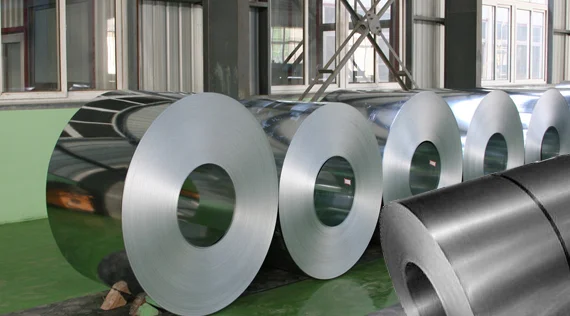China's steel cuts cloud the air for local ore miners
Steel News | 2014-09-15 06:32:49
AT the Tianjin port outside Beijing mountains of red iron ore are being processed for delivery to steelworks around China, but for the first time in recent years it is not producing the windfall that Australian miners have become so reliant upon.
The Chinese government has unveiled an ambitious plan to rapidly reduce steel production in the next few years in a bid to help solve the worsening pollution crisis, which is now the No 1 concern for many Chinese citizens.
In his first public appearance as the new Premier last year, Li Keqiang said fixing the air quality would be the top priority.
In Beijing yesterday, the Air Quality Index, which measures pollution, was more than five times the levels considered unhealthy by the World Health Organisation, and while democracy does not exist in China there is growing pressure on the government to fix the problem.
The steel production pullbacks ordered by the government are major and in the Hebei province, the centre of the Chinese steel making industry, the cuts are already being put in place. Hebei has 148 steel companies that produce about a quarter of China’s total national steel output but it is on notice from Beijing to cut production by 15 million tonnes this year, and by 60 million tonnes within the next three years.
On a national basis, China last year produced 779 million tonnes of steel and output will be cut by nearly 30 million tonnes this year.
But despite the orders from Beijing it is business as usual at the Tianjin iron ore port, the busiest seaborne facility in China. This week at least three vessels were at port and having mountains of ore from Australia unloaded.
The giant stockpiles show little of the growing sense of alarm sweeping the mines thousands of kilometres away in outback Australia. For those in the iron ore chain — from mining to trucking and shipping — it has been one of the wildest weeks for the red dirt since the global financial crisis. Prices have neared five-year lows and at current levels threaten to wipe billions of dollars from earnings of the nation’s biggest export.
One port worker, Mr Liu, told The Weekend Australian there was no shortage of work for hundreds of people on the Tianjin docks.
“I don’t know much about what the iron ore price has done but we are busy as usual; in fact, there is a lot more over time work available for us,” he said. “This dock specialises in importing iron ore. You can see, there is cargo from all over world right here now but most of our stock comes from Australia.” A steel mill worker, Mr Zhang, said the outlook for the Chinese steel industry, which has barely managed to remain profitable, was currently not bright.
“The business of steel mills is very poor right now, I do think it will recover at some point but just not this year,” he said. “We are preparing for that day when the industry gets better and since the price of iron ore is low right now, we think it is a good time to buy.”
The decision to cut steel production so sharply this year and concerns over the composition of China’s future economic growth have contributed to iron ore prices falling by more than 35 per cent this year. In trading yesterday, the commodity was at $US81.90, the lowest point in five years.
The Xinhua-China Iron Ore Index published on Tuesday showed iron ore prices at 33 major ports around China and there are fears there could be worse to come.
Analysts said the storm of negativity for prices was being driven by the Chinese steel capacity reduction, broader economic concerns and ongoing weakness in the Chinese residential housing and property development market.
It is estimated steel prices have slumped by 210 yuan ($US34) per tonne since the start of August to below 3000 yuan a tonne.
The iron ore index, which is compiled through analysis of 33 sea ports, revealed that in light of the price weakness, steel mills are hesitantly building up inventories.
It said stockpiles of imported iron ore stood at 109.06 million tonnes at the end of last week, down 300,000 tonnes from one week earlier, but the overall level of inventory was relatively high.
Westpac’s head of institutional banking, Rob Whitfield, said the falling iron ore prices would have broader negative consequences for Australian businesses, even outside the mining sector, but he said the fallout should not be disastrous.
The bank is a major lender to mining and resources companies, but Mr Whitfield said any losses from the weaker prices had so far been contained and not prompted a blowout in bad debts in the bank’s business lending book.
“The high iron ore prices that we were seeing were the unsustainable part of the cycle,” he said.
“Our loan-to-valuation ratios reflect what we were saying were unsustainably high commodity prices. We would say that iron ore prices are coming back to a much more sustainable level.
“I’m not the commodities guy to say we are now at the right level but I would say that the levels that we were seeing when they were 35 per cent higher was unsustainable and that was acknowledged.”
Lange Steel Research director Xu Xiangchun said the volatile iron ore price could start to stabilise around the current levels, given the demand conditions in China and the plunge in value so far this year. “The price could fall further but if it does it will not be by much,” Mr Xu said. “We have seen mines around the world slow their production, so the supply coming on to the market will be less this year.
“This year, the inventory that steel mills are stocking up on is growing. So far it is up about 3 million tonnes, it is a big number.”
Independent iron ore research Li Ji said the decision by the steel mills to take advantage of the weaker prices could help to support the commodity’s price in the next few months. “I think the price now should be the lowest that we will get to this year,” he said.
“I talked with several iron ore traders recently, they have bought more iron ore since the price is low. But they do not buy much, usually several hundred thousand tonnes. This buying should help to get the price higher. The price might be better in the next six months, but I would not think by all that much.”
In light of the financial market weakness, Chinese Premier Mr Li moved this week to calm nervous investor’s fears that the Chinese economy was slowing suddenly and could miss its growth target this year (7.5 per cent) for the first time in more than 15 years.
“The global economic environment has remained an intricate one since the beginning of this year. The road to recovery in developed countries has remained bumpy,” Mr Li told the World Economic Forum in Tianjin.
“Growth in emerging market economies has slowed down, and the Chinese economy faces greater downward pressure. Facing this challenging environment, we have continued to follow the general principle of making progress while maintaining stability.
“Instead of adopting strong economic stimulus or easing monetary policy, we have vigorously promoted reform and economic readjustment, and made efforts to improve people’s lives.”
Analysis from CLSA found that while China is reliant on imported ore, its own domestic mining companies will produce about 200 million tonnes this year, down from 340 million tonnes last year.
Despite that production schedule, China has also flagged that it will close a number of high-cost mines this year, once more changing the dynamics of the market.
CLSA analyst Ian Roper said despite the changing dynamics, Beijing would want to remain in control of ensuring supply both from domestic miners and overseas suppliers, especially if it looked likely official economic growth target would be missed. Chinese officials and diplomats are renowned for pressing Australian politicians and their counterparts to intervene in the iron ore market and reduce the price.
The former Chinese ambassador Fu Ying was a strong proponent of ignoring the market dynamics and having the ore price cut in her posting in Canberra from 2004 to 2007, when the Chinese economy was experiencing unprecedented growth, expanding by more than 15 per cent a year.
“After already losing capital in mining investments, would Chinese steel mills be willing to cut their losses and become dependent entirely on seaborne supply?” Mr Roper wrote in a recent note to clients. “Surely it is more likely that they will retain the bitter memories of the pain they have suffered at the hands of the iron ore oligopoly and will be willing to support their own captive supply even at a loss.
Courtesy : www.theaustralian.com.au
 By
By 